Ceramic crocks create the perfect environment for fermentation thanks to their traditional water-seal design and thick, insulating walls. You'll get better results because the crock's design naturally maintains stable temperatures while creating an oxygen-free space where beneficial bacteria thrive. The water-seal mechanism lets fermentation gases escape while blocking contaminants like dust, insects, and harmful bacteria. You won't need to manually "burp" your ferments, and they'll last up to 18 months when stored properly. Plus, the non-reactive ceramic surface prevents unwanted chemical interactions during fermentation. There's much more to discover about why these time-tested vessels produce superior results.
Benefits of Dark Fermentation

The benefits of dark fermentation extend far beyond traditional biomass processing. You'll find that this process efficiently breaks down various biomass feedstocks, including waste materials, through the action of hydrolytic microorganisms. These microbes convert complex organic matter into valuable products like hydrogen gas and volatile fatty acids (VFAs), which you can use as precursors for chemicals and biofuels. Economic viability studies show promising results for commercial-scale implementation.
What makes dark fermentation particularly attractive is its operational simplicity. You won't need complex lighting setups since it's independent of light, unlike photofermentation. The process requires less energy compared to other biological hydrogen production methods while delivering higher yield rates. You can further enhance the efficiency by integrating it with other bioprocesses like anaerobic digestion or microbial electrolysis.
You'll appreciate how dark fermentation addresses multiple challenges simultaneously. It reduces your reliance on fossil fuels while helping with waste management. Through various pretreatment methods, you can increase the soluble carbohydrate content and boost biohydrogen production.
The process also enables you to create diverse products, from organic acids and alcohols to bioplastics, making it an ideal component of microbial-based biorefineries.
Superior Nutritional Value
When you ferment foods in ceramic crocks, you're tapping into a nutrient-enriching process that greatly boosts the nutritional content of your ingredients.
Your fermented vegetables will contain elevated levels of vitamins, enzymes, and beneficial compounds produced by good bacteria during fermentation.
The process naturally enhances vitamin production, particularly B vitamins and vitamin K2, while making nutrients more bioavailable for your body to absorb. The ceramic vessel's water-filled gutter creates an ideal oxygen-free environment that maximizes nutritional benefits.
Nutrient-Rich Fermentation Process
Fermentation magic happens inside ceramic crocks, transforming ordinary vegetables into nutrient powerhouses through the action of beneficial bacteria like lactobacillus. When you ferment foods in ceramic crocks, you're creating an excellent environment for these beneficial microorganisms to thrive and produce essential vitamins, enzymes, and bioactive compounds.
Your body will better absorb the nutrients from fermented foods because the process breaks down plant cells and complex compounds into simpler, more digestible forms. The lead-free glazes used in ceramic crocks ensure no harmful substances leach into your fermented foods. You'll benefit from enhanced nutrition as the fermentation process pre-digests the food, reducing the workload on your digestive system.
The anaerobic environment in ceramic crocks guarantees prime conditions for producing these beneficial compounds while breaking down natural toxins.
You'll also get a significant boost in antioxidants, which help protect your cells from damage and contribute to better overall health. The fermentation process makes these antioxidants more bioavailable, meaning your body can use them more effectively.
Plus, you'll gain essential probiotics that support gut health, enhance immune function, and help maintain a balanced microbiome. These beneficial bacteria work to inhibit harmful pathogens while promoting better digestion and nutrient absorption.
Enhanced Vitamin Production Cycle
Inside ceramic crocks, beneficial bacteria work tirelessly to create an impressive array of vitamins during fermentation. You'll find increased levels of vitamin K, vitamin C, and other bioactive compounds as lactic acid bacteria transform carbohydrates into beneficial substances. The fermentation process doesn't just create new vitamins – it also preserves existing ones.
The ceramic crock's design plays a vital role in maintaining these nutrients. Its opaque walls block harmful UV rays while creating an oxygen-free environment that prevents vitamin degradation. You'll preserve more nutrients in this sealed, dark environment compared to other fermentation vessels.
What's particularly valuable is how fermentation enhances nutrient bioavailability. When you consume fermented foods, you're getting nutrients that are easier to digest and absorb, thanks to the breakdown of cellulose by microbial enzymes. Your body can better utilize these enhanced nutrients, supporting improved digestion and overall health.
The long-term benefits are significant. You'll get sustained probiotic support for your gut microbiome, enhanced immune function, and better mental well-being.
When stored properly in your refrigerator, these nutritional benefits can last for months, making ceramic crock fermentation an excellent choice for maintaining ideal health.
Perfect Anaerobic Environment
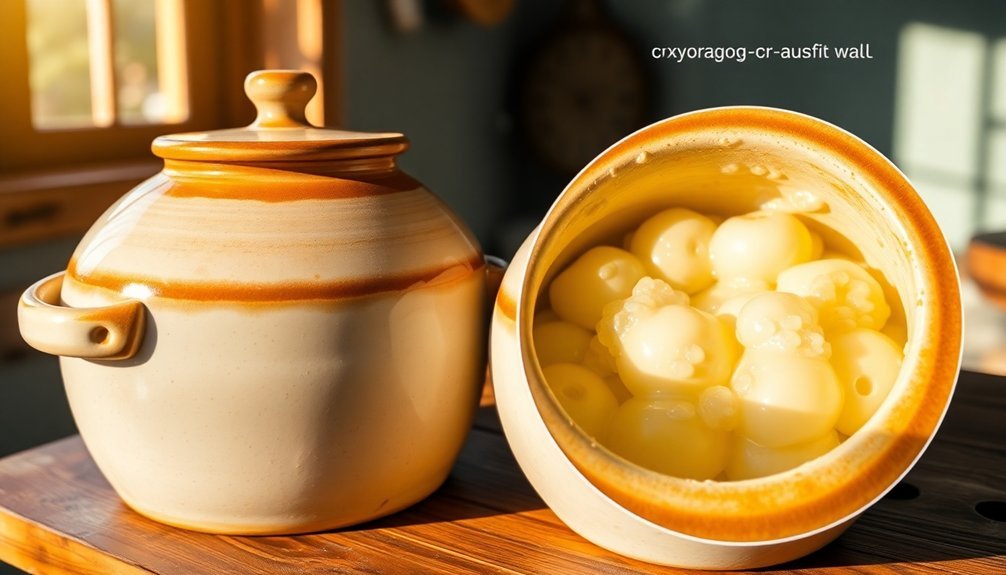
Your fermented foods will stay perfectly protected in a ceramic crock's oxygen-free environment, which is essential for successful fermentation.
The crock's unique water barrier system creates an impenetrable seal against outside air while allowing fermentation gases to escape naturally.
This clever design lets you maintain ideal anaerobic conditions without frequent opening of the vessel, greatly reducing the risk of contamination and spoilage.
Oxygen-Free Food Protection
A perfect anaerobic environment is vital for successful fermentation in ceramic crocks. You'll find that these vessels excel at creating oxygen-free conditions that protect your fermenting vegetables while promoting the growth of beneficial bacteria.
When you submerge your vegetables in brine and seal them in a ceramic crock, you're creating an ideal environment where harmful bacteria can't survive.
Your ceramic crock's ability to maintain complete darkness is important, as it shields the beneficial bacteria from damaging UV rays. You won't need to worry about frequent "burping" or opening the vessel, which helps maintain consistent anaerobic conditions.
The crock's design allows beneficial bacteria like Lactobacillus, Leuconostoc, and Pediococcus to thrive, converting carbohydrates into lactic acid.
When you use fermentation weights to keep vegetables below the brine level, you're guaranteeing continuous oxygen-free conditions. This setup prevents surface molds and yeasts from developing while allowing the beneficial bacteria to dominate the fermentation process.
The result is properly fermented food with enhanced shelf life, improved digestibility, and higher nutritional value. You'll only need to perform occasional checks to guarantee the brine level remains above your vegetables.
Sealed Water Barrier System
Traditional water-seal crocks provide an unparalleled defense system against unwanted contamination during fermentation. The ingenious water barrier creates a perfect seal that prevents airborne microbes, dust, and insects from entering your fermentation vessel while allowing fermentation gases to escape safely.
You'll notice the water level changes in the seal, which serves as a visible indicator of the fermentation's progress. You won't need to worry about "burping" your fermentation vessel, as the water seal automatically manages pressure build-up.
The system maintains consistent moisture levels by preventing brine from spilling out, ensuring your fermenting foods stay properly submerged. All you'll need to do is occasionally add water to maintain the seal's integrity.
This sealed environment promotes the growth of beneficial bacteria like Lactobacillus, Leuconostoc, and Pediococcus, which thrive in anaerobic conditions. The result is superior flavor development and more consistent fermentation outcomes.
With custom-fitted covers and proper weights keeping your food below the brine, you'll achieve even fermentation throughout your batch while maintaining ideal hygiene standards. This controlled environment eliminates the need for repeated opening and closing, greatly reducing the risk of contamination.
Contamination Prevention Methods
Successful fermentation depends on maintaining a clean, controlled environment to prevent contamination. You'll need to thoroughly wash your ceramic crock in hot soapy water and properly sanitize it before each use. While bleach solutions can be effective, you must rinse them completely to avoid any residual chemicals affecting your fermentation.
Your ceramic crock's water-sealed design creates multiple barriers against contamination. The water channel acts as a protective seal, keeping out insects and dust while allowing fermentation gases to escape. The dark, UV-protected environment inside the crock helps preserve beneficial bacteria and prevents degradation of your fermented foods.
| Prevention Method | Benefits |
|---|---|
| Water Seal | Blocks insects, dust while releasing gases |
| Dark Environment | Protects beneficial bacteria from UV damage |
| Smooth Surface | Prevents bacterial growth in crevices |
The ceramic material itself plays an essential role in contamination prevention. Unlike metal containers that can pit or wooden vessels that are hard to sanitize, ceramic crocks won't degrade or harbor harmful bacteria. You'll want to verify your crock is free from chips or scratches, as these can become breeding grounds for unwanted microorganisms.
Easy Maintenance and Operation

You'll find ceramic crocks remarkably easy to maintain with their simple water channel system that automatically releases fermentation gases while keeping air out.
Setting up your fermentation is a straightforward one-step process of adding your prepared ingredients, weights, and water to the channel.
The cleaning process requires minimal effort, as you can simply wash the crock with hot soapy water and use vinegar for any stubborn spots.
Simple Water Channel System
A foolproof water channel system lies at the heart of ceramic fermentation crocks, providing an elegant seal between your fermenting foods and the outside world. The channel creates an anaerobic environment that's vital for proper fermentation while allowing carbon dioxide to escape automatically. As CO2 builds up during fermentation, it pushes through the water seal, maintaining ideal pressure inside the crock.
You'll need to check the water level about once a week and refill as needed due to natural evaporation. This simple maintenance step is important – if the water level drops too low, the seal breaks, allowing unwanted air to enter. When you maintain proper water levels, you're protecting your ferments from harmful yeasts, molds, and outside contaminants.
The system's benefits extend beyond its sealing capabilities. You'll find that the water channel keeps fermentation odors contained while blocking dust and insects.
Combined with the crock's thick ceramic walls and dark environment, you're creating favorable conditions for lactic acid-producing bacteria to thrive. This makes ceramic crocks particularly effective for producing large batches of consistently fermented foods.
Clean With Minimal Effort
While maintaining a ceramic fermentation crock might seem challenging, the cleaning process requires minimal effort when done correctly. You'll find that simple hot, soapy water is all you need for regular cleaning, and it's best to avoid harsh chemicals or dishwashers that could damage your crock.
After cleaning, let it air dry completely to prevent moisture-related issues.
Your fermentation weights need special attention, but they're also easy to maintain. Boil them after each use and store them separately in a well-ventilated area to prevent mold growth. If you notice any mold, hot water and elbow grease usually do the trick.
To keep your fermentation process clean and efficient:
- Use a water-sealed crock to minimize odors and reduce the risk of contamination
- Keep vegetables fully submerged under the brine using weights
- Regularly check and remove any surface scum with a clean spatula
Don't worry if you spot some surface mold or yeast – it's common and doesn't usually indicate spoilage. Simply skim it off and make sure your vegetables remain submerged.
Remember to cover your crock with a thin towel to allow gases to escape while keeping debris out.
One-Step Setup Process
Beyond the simple cleaning routine, ceramic crocks stand out for their remarkably straightforward setup process. You'll find that the water-sealed mechanism eliminates complex preparations, requiring only three basic steps: placing your food in the crock, adding brine, and positioning the weights. The crock's ingenious design guarantees your fermenting foods stay perfectly submerged without additional equipment.
The automated air control system works silently in the background through a water gutter that lets fermenting gases escape while keeping outside air at bay. You won't need to manually burp the container, and the water seal protects your fermentation from external contaminants.
| Feature | Benefit |
|---|---|
| Water-Sealed Lid | Prevents contamination while releasing gases |
| Stone Weights | Maintains consistent food submersion |
| Automated Ventilation | Eliminates manual burping needs |
| Self-Maintaining Design | Reduces daily monitoring requirements |
The ceramic weights provide full-coverage submersion, guaranteeing even fermentation throughout your batch. You'll appreciate how the crock's structure prevents dirty water from overflowing into the outer wall cavity, maintaining a clean environment throughout the fermentation process. This design creates a reliable, hands-off experience that delivers consistent results every time.
Large Batch Processing Capabilities
Large ceramic crocks excel at processing substantial quantities of fermented foods, with capacities ranging from 1.3 to 2.5 gallons. You'll find that a single gallon-sized crock can ferment 4-5 cabbages worth of sauerkraut, making it perfect for family-sized batches or seasonal preservation.
These vessels are specifically designed to handle large quantities efficiently through several key features:
- Semi-circle weights keep vegetables fully submerged in brine
- Interior and exterior lid systems maintain an ideal anaerobic environment
- Straight cylinder shapes provide easy access for monitoring and maintenance
You'll appreciate how ceramic crocks maintain consistent fermentation conditions while accommodating substantial volumes. The non-porous surface won't absorb odors or stains, ensuring hygienic conditions batch after batch.
You can safely fill these crocks to about 75% capacity, allowing proper space for fermentation activity without overflow.
The durability of ceramic crocks, enhanced by their protective glazes, makes them a practical investment for regular large-batch fermentation.
Whether you're using a Kenley Fermentation Crock or an Ohio Stoneware Bristol model, you'll have a reliable vessel that combines functionality with the ability to process significant quantities of fermented foods.
Water Seal Technology
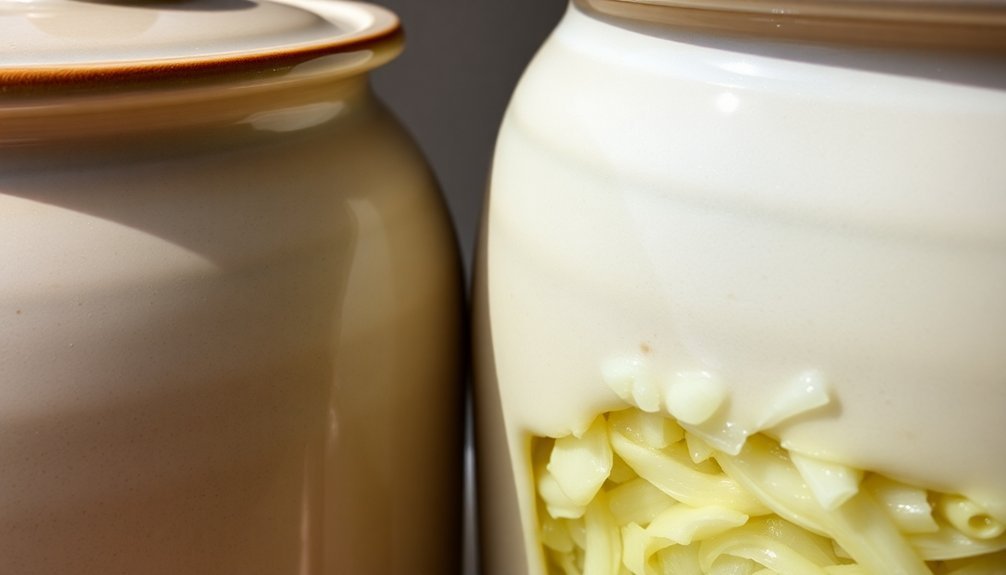
Water seal technology stands as one of the most innovative features of ceramic fermentation crocks. You'll find a specialized water channel or gutter around the crock's rim that creates an airtight seal when filled with water. This ingenious design lets carbon dioxide escape while preventing outside air from entering, creating the perfect anaerobic environment for lactic acid fermentation.
You won't need to worry about contaminants like dust, insects, or wild yeasts spoiling your ferments, as the water barrier effectively blocks their entry. The seal also prevents surface molds and oxidation, which can compromise the quality of your fermented foods.
You'll appreciate how this technology simplifies the fermentation process. There's no need for daily "burping" or monitoring – you'll only need to occasionally top off the water level as it evaporates. The system works continuously to maintain ideal conditions, ensuring consistent and predictable outcomes in your ferments.
The result? You'll get better-tasting batches with enhanced nutritional value. The water seal prevents Kahm yeast formation and maintains ideal fermentation conditions, leading to superior quality compared to simpler fermentation methods like mason jars.
Temperature Control Properties
Ceramic fermentation crocks offer remarkable temperature control properties that complement their water seal technology. The thick ceramic walls, fired at temperatures exceeding 2200 degrees, create a naturally insulating vessel that maintains stable internal temperatures throughout your fermentation process.
You'll find that these crocks excel at temperature regulation through three key mechanisms:
- Even heat distribution through the thick walls prevents hot spots and guarantees uniform fermentation
- Natural insulation properties shield your ferments from external temperature fluctuations
- Opaque ceramic material blocks harmful UV light that can disrupt the fermentation process
When you're fermenting foods like sauerkraut or kimchi, you'll appreciate how the crock maintains warmer temperatures during the initial fermentation peak and cooler temperatures during the aging process.
This temperature stability is vital for developing ideal flavors and nutrients while preventing unwanted microbial growth. The crock's ability to resist environmental changes means you can place it in various kitchen locations without compromising your ferment's quality.
The consistent internal environment created by the ceramic material supports predictable fermentation outcomes and reduces the risk of spoilage from temperature fluctuations.
Traditional Preservation Techniques
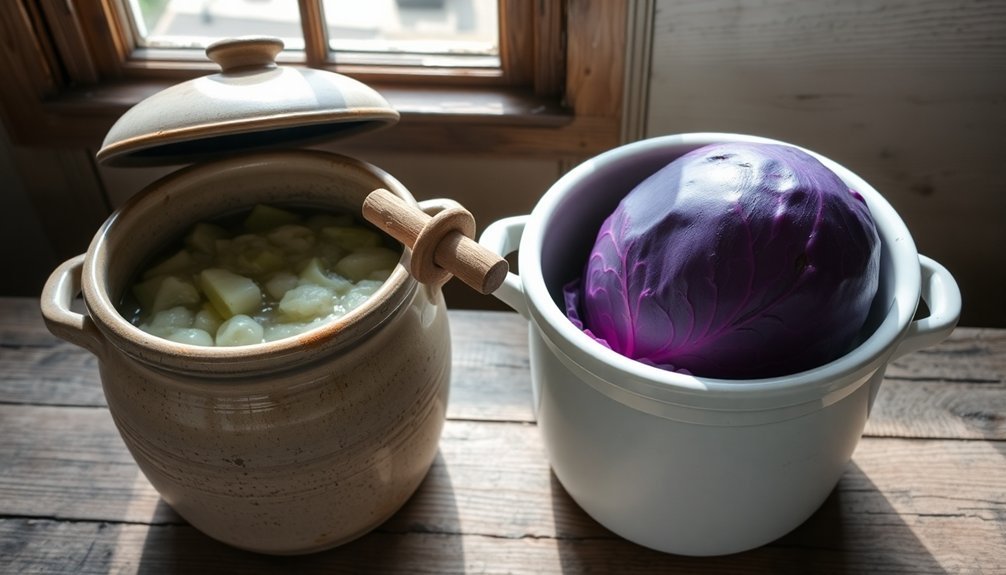
Throughout human history, traditional fermentation has served as a cornerstone of food preservation, with ceramic crocks playing an essential role in this time-tested process. You'll find that ancient civilizations from Egypt to China relied on fermentation not just for preservation but also to create nutritious, flavorful foods like bread, beer, and soy sauce.
When you're using ceramic crocks for fermentation, you're participating in a preservation method that's proven effective for thousands of years. These vessels create the perfect environment for beneficial bacteria to thrive while producing lactic acid, which naturally preserves your food.
You're also tapping into a process that enhances your food's nutritional value by increasing vitamin content and bioavailability of nutrients.
The water-sealed design of ceramic crocks offers you a significant advantage over other traditional vessels. You'll notice they're specifically engineered to keep air out while allowing carbon dioxide to escape, preventing contamination and spoilage.
This design has made ceramic crocks particularly effective for making traditional foods like sauerkraut, where maintaining a controlled environment is vital for successful fermentation and long-term preservation.
Enhanced Flavor Development
Successfully controlling flavor development in fermented foods starts with your ceramic crock's unique design features. The anaerobic environment created by your crock's water seal prevents unwanted air exposure while allowing fermentation gases to escape, ensuring consistent flavor development without frequent burping.
Temperature management plays a significant role in how your ferment's flavors develop. You'll get different results based on your environment:
- Below 75°F: Milder flavors develop over 4-6 weeks
- Above 75°F: Tangier results emerge in 2-3 weeks
- Storage at 38°F: Preserves developed flavors after fermentation
Your ceramic crock's design helps prevent contamination that could affect flavor. The water seal keeps out dust and insects, while the weights keep ingredients submerged in brine, preventing mold growth and ensuring even fermentation throughout your batch.
If you notice kahm yeast on the surface, you can simply skim it off without affecting the fermentation process.
The crock's design also accommodates the natural expansion of ingredients during fermentation while maintaining proper brine coverage. This consistent submersion is essential for developing clean, balanced flavors in your fermented foods.
Space Efficient Design
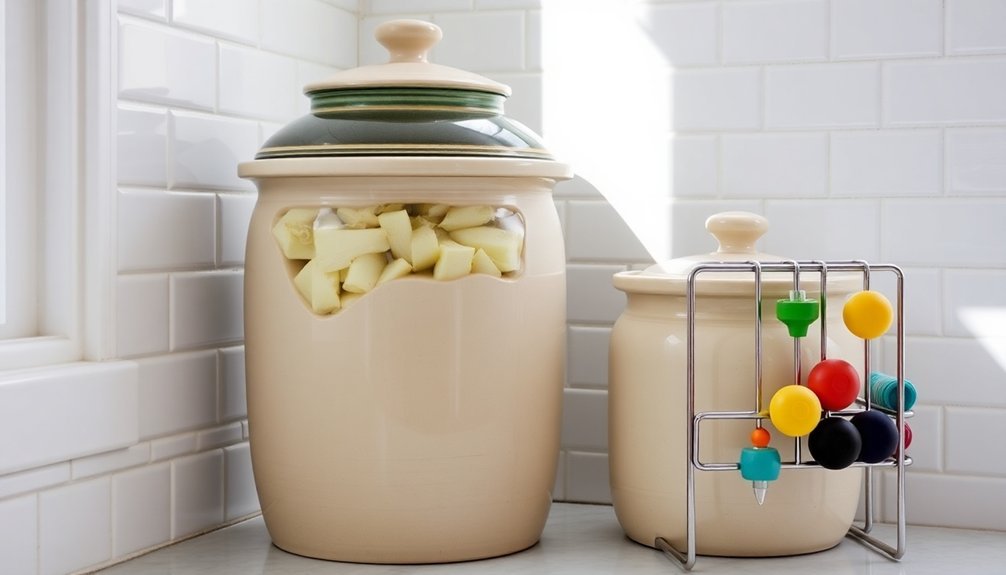
When space efficiency matters in your kitchen, ceramic crocks deliver impressive capacity without monopolizing your countertop. You'll get up to 30 times more fermented food compared to standard mason jars, with even the smallest crocks producing 4 times more than a pint jar.
The straight cylindrical design of ceramic crocks makes them incredibly practical. You won't struggle with cleaning or accessing your ferments, and the shape prevents common issues like wedged lids or expanding materials during fermentation.
| Feature | Benefit | Impact |
|---|---|---|
| Straight Walls | Easy cleaning | Reduces maintenance time |
| Semi-circle Weights | Complete coverage | guarantees proper fermentation |
| Water-sealed Lids | Airtight protection | Prevents contamination |
| Size Options | Scalable capacity | Fits your needs |
You'll find ceramic crocks in sizes ranging from 1-2L "City" models perfect for small households to 45L vessels for large-batch fermentation. The design incorporates heavy weights (typically three pounds) and water-channel sealing systems that keep your ferments properly submerged and protected. Whether you're making sauerkraut, kimchi, or pickles, you'll appreciate how the space-efficient design simplifies the entire process from setup to cleanup.
Long Term Storage Solutions
Stability is key to preserving fermented foods, and ceramic crocks excel at maintaining excellent storage conditions. With proper storage in cool, dark locations, you'll find that fermented vegetables can last up to 18 months. The thick ceramic walls and water-sealed top create an environment that's perfect for long-term preservation, keeping your ferments at a consistent temperature between 60-65°F (16-18°C).
When you're planning for extended storage, remember these essential conditions for top-notch preservation:
- Store your crocks in a cold cellar or refrigerator to slow fermentation (32-50°F)
- Keep ferments in complete darkness to maintain quality
- Make sure the water seal remains filled to prevent contamination
Your storage timeline will vary depending on what you're fermenting. While vegetables can last a year or longer, you'll want to consume fermented fruits within a few weeks to a month.
If you need to completely halt the fermentation process, you can freeze your ferments, but make sure to protect them from freezer burn. The beauty of ceramic crocks lies in their ability to maintain these excellent conditions naturally, making them superior vessels for long-term storage.
Natural Material Advantages
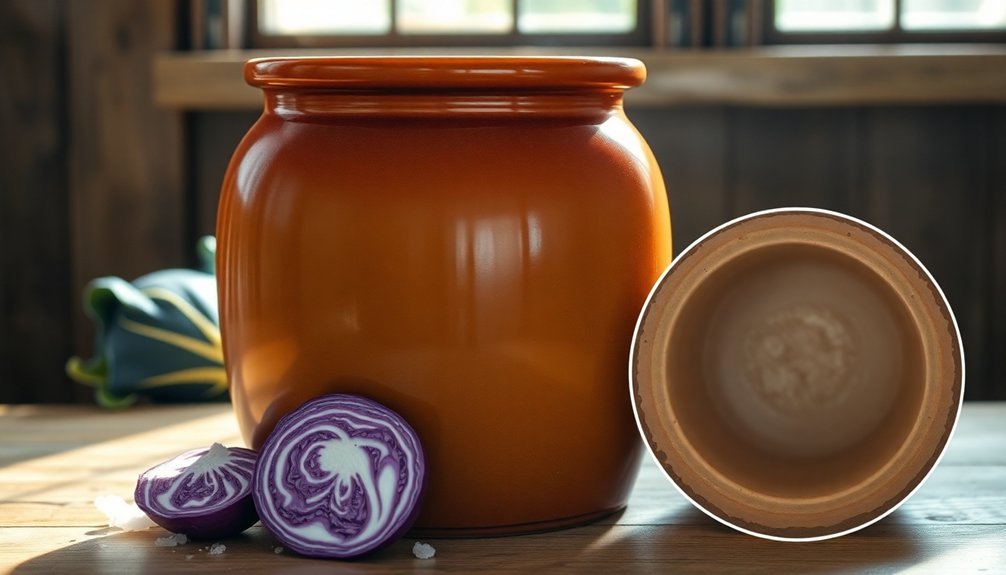
Beyond their impressive storage capabilities, ceramic crocks offer remarkable advantages thanks to their natural material composition. The high-fire ceramic construction provides a non-reactive, food-safe environment that won't break down during fermentation, unlike materials such as limestone that can dissolve in acidic conditions.
You'll find that ceramic's natural insulating properties help maintain stable fermentation temperatures, while its thick walls create the perfect dark environment for your ferments. This darkness is essential as it blocks harmful UV rays that could kill beneficial lactic acid-producing bacteria and degrade the color, flavor, and nutrients of your fermented foods.
The material's durability means you're investing in a long-lasting fermentation vessel that's built to withstand repeated use. Since these crocks are often handmade, you'll get a unique piece that combines functionality with craftsmanship.
The ceramic's natural properties also contribute to the effectiveness of the water-seal mechanism, creating an ideal anaerobic environment where beneficial bacteria can thrive while allowing fermentation gases to escape safely through the water moat.
Frequently Asked Questions
How Long Does a Ceramic Fermentation Crock Typically Last With Proper Care?
With proper care and regular maintenance, your ceramic fermentation crock can last 20-30 years or more. You'll need to clean it thoroughly after each use and avoid exposing it to extreme temperatures.
Can Ceramic Crocks Be Used for Hot Fermentation Processes?
You can't use ceramic crocks for hot fermentation, as they're designed for room temperature processes. While they're great for fermenting hot peppers, the actual fermentation should occur at normal room temperatures.
What Happens if the Water Seal Completely Evaporates During Fermentation?
If your water seal evaporates, you'll lose the anaerobic environment, allowing air and contaminants to enter. This can lead to mold growth, spoilage of your ferment, and you'll need to refill it immediately.
Are There Specific Foods That Should Not Be Fermented in Ceramic Crocks?
You shouldn't ferment kombucha, delicate fruits, or foods needing frequent stirring in ceramic crocks. Also avoid high-starch items like potatoes and foods requiring oxygen, as they won't ferment properly in the sealed environment.
Do Ceramic Crocks Need to Be Seasoned Before Their First Use?
You don't need to season ceramic crocks before first use. Just wash them thoroughly with warm soapy water, rinse well, and dry completely. Make sure to inspect for any defects before starting your fermentation project.
In Summary
You'll find ceramic crocks are the gold standard for fermentation, offering durability and natural temperature control. They'll protect your ferments from harmful UV rays while maintaining the perfect anaerobic environment. You won't need to worry about chemical leaching, and their weight helps keep vegetables submerged. With proper care, your ceramic crock will serve generations of fermenters, making it a worthwhile investment for your kitchen.





Leave a Reply